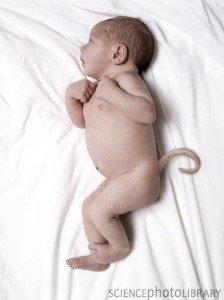Jun
8
When a Tail Is Just a Tale
Growing up, I always had a fascination with “human oddities” (among other things). I would read about them in the latest Guinness Book of World Records and Ripley’s Believe It or Not books. From dwarves and giants to Siamese twins, people with blue skin, 14 toes, a third arm, skin like tree bark, or their heart on the “wrong” side of their body. Weird (or, at least, unusual), sometimes gross, often sad, but true.
 One genetic anomaly that one hears about from time to time — mostly in science debates/discussions or in popular fiction, because it is actually very rare — is a human born with a “vestigial tail”. Certain pagan cultures tout this sort of thing as evidence of divinity or divine blessing. The kid (and his/her parents) become local celebrities, of a sort. Among more modern cultures/societies, most people consider such things an unwelcome deformity and an embarrassment to be surgically removed as soon as possible. But, evolutionists — professionals (e.g., Jerry Coyne, Karl Giberson) and laymen alike — point to such “tails” as evidence for atavism, i.e., an evolutionary throwback “proving” Darwin was right (or, at the very least, common descent).
One genetic anomaly that one hears about from time to time — mostly in science debates/discussions or in popular fiction, because it is actually very rare — is a human born with a “vestigial tail”. Certain pagan cultures tout this sort of thing as evidence of divinity or divine blessing. The kid (and his/her parents) become local celebrities, of a sort. Among more modern cultures/societies, most people consider such things an unwelcome deformity and an embarrassment to be surgically removed as soon as possible. But, evolutionists — professionals (e.g., Jerry Coyne, Karl Giberson) and laymen alike — point to such “tails” as evidence for atavism, i.e., an evolutionary throwback “proving” Darwin was right (or, at the very least, common descent).
The evolution advocates claim that sometimes “babies are born with perfectly formed, even functional tails,” but they otherwise tend to be quite healthy. Also,
“The scientific explanation is that we inherited these instructions from our tailed ancestors but the instructions for producing them have been shut off in our genomes…. Sometimes the ‘ignore these genes’ message gets lost in fetal development, however.” (Giberson)
Many would accept these claims and concede, “Oh? Well, that *does* seem like a reasonable explanation. They may have a point.” But, is it, really? Fortunately, most doctors these days don’t fall for the Darwinist propoganda on this matter, instead turning to the mountains of clinical research evidence documented in medical journals. The real data reveals that these “tails” are not “perfectly formed [or] functional,” and they are typically indicators that the baby has serious associated neurological defects, as well. As for the etiological claim, Casey Luskin of The Discovery Institute sums it up:
“The exact causes of tails are debated, but because of their persistent association with neurological defects, the most plausible view is that they result from abnormalities and deviations in development.”
In fact, Luskin recently wrote a series of articles on this “icon of evolution”, where he examines both the claims and the facts more closely. For example, researchers have traditionally recognized two types:
“‘true tails,’ which extend from the coccyx (tailbone) where one might expect a so-called ‘vestigial tail,’ and ‘pseudotails’ which are often found in other locations on the lower back, and seem to be obvious aberrations since they are often associated with anomalies.
This distinction is based upon evolutionary assumptions, … [for] even such so-called ‘tails’ aren’t anything like those found in tailed mammals.”
He goes on to quote the Journal of Neurosurgery (which is echoed by other prominent medical research journals):
“In all reported cases, the vestigial human tail lacks bone, cartilage, notochord, and spinal cord. It is unique in this feature.”
 So-called “pseudotails” can contain some bone. But, they are located at various places along the lower back, even off to the side, and do not contain vertebrae. Rather, as the Journal of Child Neurology (and others) point out,
So-called “pseudotails” can contain some bone. But, they are located at various places along the lower back, even off to the side, and do not contain vertebrae. Rather, as the Journal of Child Neurology (and others) point out,
“The pseudotail is an anomalous prolongation of the coccygeal vertebra, lipoma, teratoma, chondrodystrophy, or parasitic fetus.”
I’ll let you look up those other terms, but you get the gist. Also,
“The pseudotail is often short, stump-like, and occasionally bulging.”
Later in the series, Luskin delves into the harm that has resulted — more so in the past than now — from doctors’ and medical researchers’ Darwinian assumptions. For example,
“A paper in Journal of Child Neurology likewise elaborates the dangers of failing to look for these other defects, since the human tail ‘can be associated with an underlying spinal lesion that, if not recognized early, can lead to permanent neurologic disabilities.’ If you treat the tail as a vestigial throwback in ‘otherwise healthy’ babies, then you won’t do the detailed examinations necessary to find these problems and properly treat them.”
Unfortunately, similar damage has been done, and lack of progress made, due to other evolutionist/Darwinist assumptions, too (e.g., “junk DNA”).
There is a lot more, of course, and I recommend reading Luskin’s series (linked below). In a subsequent article, Dr. Michael Egnor (Vice-Chairman, Department of Neurological Surgery / Director, Pediatric Neurosurgery, at State University of New York at Stony Brook) applauds Luskin’s research and adds confirmation from his own experience treating and operating on children with these and other deformities. I’ll end with an excerpt from Egnor’s article:
“A tail has vertebrae, is a continuation of the coccyx, has developed muscles, nerves and other soft tissues, etc. The appendages described in the literature, and all of the appendages on which I have operated, are dysmorphic mesenchymal tissue, often epithelialized exophytic dermal sinus tracts, that bear a superficial resemblance to a “tail.” None have the structure of a tail, even in rudimentary form, and none of the ones I have operated on were attached to the coccyx in the way that a tail is. I don’t know what to make of the terms ‘true tail’ and ‘pseudo-tail’ — I’ve yet to find a cogent definition, and I don’t know of any case report of a genuine tail in a human being….
There is no reason whatsoever to associate it with any sort of ‘evolutionary regression’ or any such nonsense. Again, these Darwinists really have to let ‘ontogeny recapitulates phylogeny’ go. It’s embarrassing.”
—
Part 1: Another Icon of Evolution: The Darwinian Myth of Human “Tails”
Part 2: Are Humans Ever Born with “Perfectly Formed” Tails?
Part 3: Do Human “Tails” Represent the Simple “Turning On” of Genes Retained from Our Ancestors?
Part 4: Are Human Tails Mere “Vestigial” or “Benign” Structures Born to “Otherwise Healthy” Babies?
Part 5: How the Darwinian View of Human “Tails” Leads to Harmful Medical Practices















